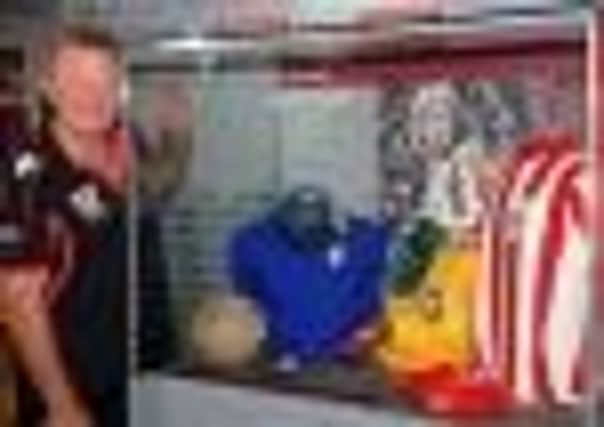Kiss and tell as icon Currie to spice up fans’ tours


Tony Currie was one such player, a star whose footballing genius lit up Bramall Lane when Sheffield United could last genuinely lay claim to a place at English football’s top table.
The fans appropriated the 1972 pop hit You Can Do Magic to serenade their hero who reciprocated by blowing kisses as they marvelled at Currie’s ability to dribble, pass, shoot and generally mesmerise even the highest-quality opposition.
Advertisement
Hide AdAdvertisement
Hide AdThe memories are many. Chief among them are a 35-yard screamer past Liverpool’s then England goalkeeper Ray Clemence and a cute dribble before arrogantly passing the ball into the corner of the net against West Ham – a goal immortalised by John Motson’s commentary on Match of the Day which became its trademark: “A quality goal by a quality player”.


Currie is about to begin running guided tours around the Blades’ museum and stadium and, as he rolled back the years yesterday, football in the 70s seemed a game much more enjoyed for its own sake rather than the carefully choreographed, money-making machine it now often appears.
It was a time when Currie could stop mid-game and sit on the ball to taunt England World Cup winner Alan Ball during a 5-0 thrashing of Arsenal.
“He first did it at Highbury when they beat us 5-0. I was three yards away and I just clapped him,” Currie said. “He was taking ‘the mick’ but we were good mates from playing for England together.
Advertisement
Hide AdAdvertisement
Hide Ad“But two years later the roles were reversed. I had scored two in the first 20 minutes and it was my turn to get my own back. He clapped and said: ‘I’ll have one for you next time’.”


And Ball, who passed away four years ago, was true to his word. Currie recalled him stopping to put his foot on the ball and pretending to tie his laces when the teams met again.
Then there was Currie’s famous kiss with Leicester City’s Alan Birchenall, a moment captured by Match of the Day in 1975. Players’ kisses are ten-a-penny these days but at the time the Bramall Lane puckering-up garnered headlines far beyond the UK and turned the duo into unlikely gay icons in Germany.
Currie said: “It was just off the cuff. I don’t know if I was chasing him or the other way round or who was tackling who but it was like synchronised swimming, we went head over heels and ended up face to face.
“He said ‘give me a kiss, TC’ and I did. It just happened.”


Advertisement
Hide AdAdvertisement
Hide AdAnd there were the kisses blown to the Bramall Lane crowd as United gained a reputation for playing free-flowing football, culminating in a sixth place finish in 1975, only four points behind champions Derby.
Currie had started life as a striker at Watford where he first came to prominence by scoring nine goals in his first six games. He remembered Arsenal sniffing around at the time but it was less fashionable Sheffield United who decided to make the definitive move and he headed north instead.
The goals initially dried up but then Blades manager John Harris moved Currie back into midfield and a legend was born. “It was when I moved into midfield that it started to happen. I was hitting 60 or 70-yard cross-field passes and I was thinking ‘bloody hell, I’m not bad at this’.
“The crowd were loving it and I started blowing kisses, it just happened. In the end, the crowd just expected it.”
Advertisement
Hide AdAdvertisement
Hide AdAt the time, Currie was treading a path first travelled by George Best, the first footballer to take on rock star status in the late 1960s.
He wasn’t alone – names like Frank Worthington, Stan Bowles, Alan Hudson and Rodney Marsh represented a string of flair players in the 1970s who became as well known for playing to the gallery as playing the game itself.
Like Currie, they all flirted with England’s national team rather than becoming fixtures in the side.
Currie got 17 caps, 11 of which came after he left United to join Leeds in 1976, and feels he would have got more if Leeds’s own legend, Don Revie, hadn’t become England manager.
Advertisement
Hide AdAdvertisement
Hide Ad“I think we got 40 caps between us – and I was luckier than them as I got 17. Managers have got their favourites – obviously we weren’t Revie’s favourites, I can tell you that. I would probably have got more caps if (Sir) Alf Ramsey had stayed manager.”
Currie acknowledged “it would have been a brave manager to have picked us all” but added, “though the other team might have struggled to get the ball off us a few times”.
* Tony Currie’s tours of the museum and ground will run on Tuesdays and Wednesdays. Tickets are £5 for adults and £3 concessions and include a signed picture.
TALENT GRACED TWO UNITED
Tony Currie joined Sheffield United in 1968 from Watford for a transfer fee of £26,500.
Advertisement
Hide AdAdvertisement
Hide AdHe went on to play 313 games for the Blades, scoring 54 goals.
But the good times ended with relegation from the top division in 1976 and Currie was transferred to Leeds for ten times his original fee.
He played 102 times for Leeds, scoring 11 goals. In 1979 he moved to Queens Park Rangers and captained the club in the 1982 FA Cup final replay against Spurs.
Injuries then began to take their toll and Currie drifted out of the game before returning to Bramall Lane where he ran United’s community programme for 20 years before taking up an ambassadorial role three years ago.